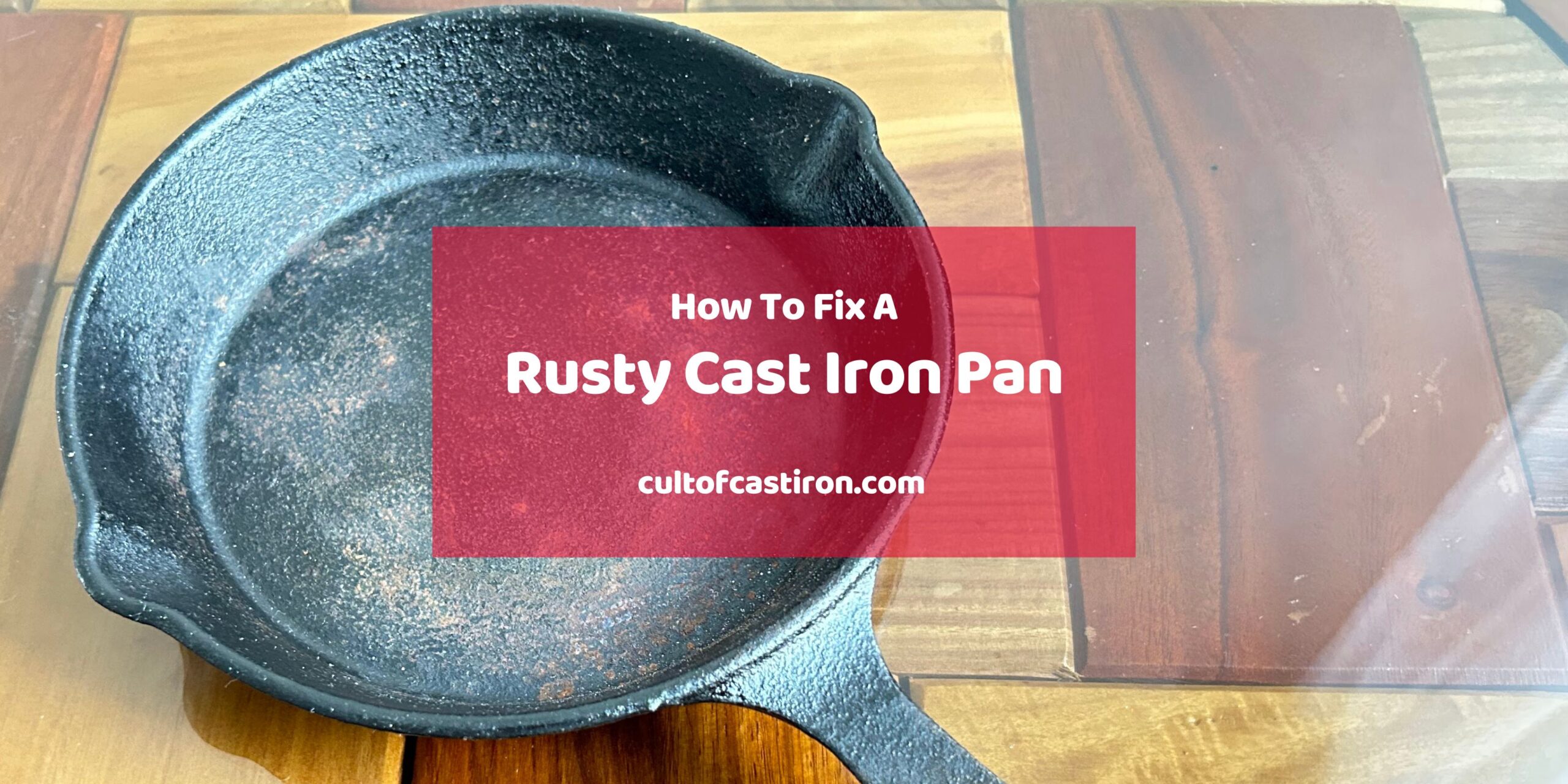Cast iron pans are incredibly durable given that they are properly seasoned and maintained. However, first-time cast iron users may be surprised that their new pans are prone to rusting at the slightest hint of moisture.
We all know that the reason why cast iron pans develop rust is that it was exposed to moisture for a significant period of time. The more important question is: how did water molecules find their way to the bare metal of the cast iron? Whether it be poor seasoning, improper drying and storage practices, or cooking with acidic food, this rusting predicament can be easily reversed in a few simple steps.
Keep reading as we take a more in-depth look at why your cast iron pan developed rust, and how you can prevent it from happening in the future.
5 Reasons Why Your Cast Iron Pan is Rusty (and 5 Solutions To Keep Them from Rusting)
There are many reasons why your cast iron pan developed rust. Try to retrace your steps to identify which of these reasons is the root cause of your problem.
1. You let the pan soak in water for a long time
It is generally safe to soak your cast iron pan in water and soap to loosen food residue that is stuck on the surface. However, leaving the pan soaked in water for too long will allow moisture to percolate into the pores of the cast iron pan, and cause surface rust to form.
Mind you, the soap did not cause this. It is widely accepted now that modern soaps are made out of milder ingredients that are not likely to damage your cast iron pan. In contrast, lye-based soaps of old are said to be capable of damaging the cast iron’s seasoning, and even reacting with the iron itself.
The Solution: If stuck food residue is your problem, the easiest way to avoid soaking the pan for a long time is by cleaning it while it is still hot. This helps loosen up food residue for easy scrubbing later on. If you want to clean the pan after eating, then put a little bit of water on the pan and then heat it on the stove. Make sure to scrub the pan while the water is still warm.
2. You air-dried your pan
When it comes to cast iron and rust, time under exposure to moisture is the most important factor to consider. That is why it is important not to let your pan dry in the air after washing because any stray water molecule that lingers on the surface of the pan is bound to react to it, causing rust.
The Solution: After washing the cast iron pan, make sure to dry it with a towel and heat it in an oven or on a stove until it is bone dry. This ensures that no moisture is present in the pores of the pan.
3. You stored the pan in a humid environment
Apart from the beads of water on the surface of your cast iron pan, you must also be aware of the moisture in the air where you store it. HIgh humidity levels can oxidize iron and lead to rust. The most common areas prone to high humidity are spaces under the sink or beside the dishwasher.
The Solution: When in doubt, choose a well-ventilated area to store your cast iron cookware in, as air circulation can help prevent moisture from accumulating around the pan. The best option for me is letting them hang from hooks in the kitchen. You can even stow them in the oven if the oven is large enough. For lidded cookware like dutch ovens and braisers, it is best to store them with the lid off to allow air to circulate on the interior parts of the cookware.
4. You did not season the pan well
The seasoning on a cast iron pan serves two functions: it gives the pan non-stick qualities and also gives it resistance to rust (take note: rust resistance, not rust proof). The polymerized layer of oil acts as a hydrophobic layer that repels water and prevents moisture from penetrating into the bare cast iron pan.
Any problems with the seasoning, like flaking and scratches can weaken the overall constitution of the seasoning layer, and thus present opportunities for moisture to find its way to the iron and lead to rusting.
The Solution: First, read our guide on how to fix the seasoning if it is flaking off or if it has scratches. Second, read our other comprehensive guide on how to season your cast iron pan properly to prevent rust from developing.
5. You cooked with acidic ingredients
Cooking acidic food in a cast iron pan can potentially cause the pan to rust. I said “can” here because this mostly applies if the pan’s seasoning is poor or not yet established. The acids can break down the seasoning layer on the pan, which may lead to iron being exposed to moisture which causes rust to form.
The Solution: The simplest way to avoid this problem is by using your enameled cast iron cookware to cook acidic food. If you only have an unenameled cast iron pan in your kitchen, you can still cook acidic food on it, but make sure to properly clean and oil it afterwards to prevent rusting.
Can You Cook On a Rusty Cast Iron Pan?
No, you should not cook on a rusty cast iron pan. According to the USDA, rust is not a food-safe material that should not be ingested. Granted, ingesting small amounts of rust will likely not produce any immediate harmful effects, but it is still advisable to play on the safe side.
Besides, fixing a rusty cast iron pan is easy enough to do in a few minutes, so there really is no excuse to not remove surface rust before cooking with the pan.
How To Fix a Rusty Cast Iron Pan in 4 Steps
Fixing a rusty cast iron pan is easier than you think – you’ll only need a few things and a lot of elbow grease to get the job done. Here’s how you can remove rust from your cast iron pan and restore its sheen.
1. Soak the pan with equal parts water and vinegar
Note: this is mostly done for severe cases; for minor surface rusts, skip to step #2
After all of the warnings stated earlier about how cooking acidic food will negatively impact your seasoning, you may be surprised to read that you will need to soak the entire thing in acid. This is because apart from making rust loosen from the iron, the vinegar also strips away the remaining seasoning layers on the pan. It is better to start the seasoning layer from scratch to ensure that it will bond to the metal properly.
To do this, grab a large enough container and mix an equal part of water and vinegar, then drop your pan in the mixture for a few hours, or even overnight. This should help to loosen the rust for the next step.
2. Scour the surface with a steel wool
Next, use a scrub brush or steel wool to remove as much rust as possible from the pan. You can also use salt or a mixture of baking soda and water to create a paste and scrub the rust off. Continue scrubbing until you see the original dark gray color of bare cast iron.
3. Rinse and dry you pan
Once you have removed as much rust as possible, rinse the pan with water and dry it thoroughly with a towel. You may have to repeat this and the previous step if the rust is particularly stubborn.
In preparation for the next step, wipe the pan until all traces of water are absent anywhere on the pan. After that, place the pan on a burner for a few minutes to ensure that the pan is bone dry before applying a layer of seasoning.
By the way, you may see a few specks of rust forming on the pan if you take a few minutes doing this. Don’t worry though, as that is just new surface rust forming. You can wipe it off with a rag without any problem.
4. Reseason your bare cast iron pan
Now that the pan is dry, it is now ready to be reseasoned!
Put a few drops of oil on the pan and rub it on every nook and cranny you can see. Make sure that there are no dull spots on the pan. Once you’ve applied the oil all over the pan, wipe away any excess oils using a towel or a rag, then heat it until you’ve reached the smoke point of the oil. Once the oil looks dry, the seasoning has set! Apply another layer of oil on the pan to keep it from rusting while in storage, and you’re done!
If you want a more detailed look into the proper cast iron seasoning process, be sure to click the linked article here.
Wrapping Up
While fixing a rusty cast iron pan is not a hard endeavor, I think we can all agree that prevention is better than cure.
If you’re still hungry for more information on everything about cast iron cookware, then be sure to check out the rest of the Cult of Cast Iron blog!

Miguel is a cast iron enthusiast from Cavite, Philippines. He works in the digital marketing field as a content marketing strategist. On the side, he manages a small online bookstore and tends to his plants.

